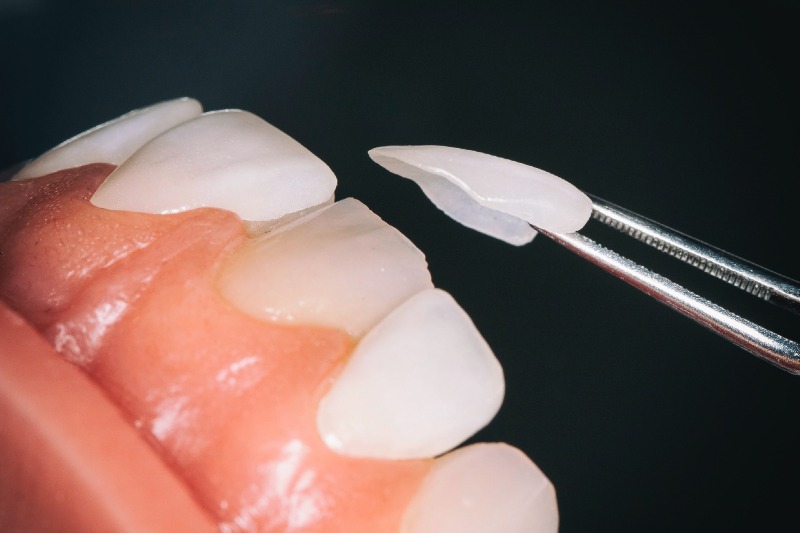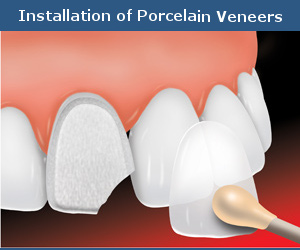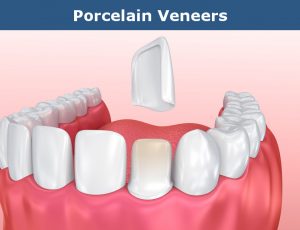Porcelain Veneers Glendale

Porcelain veneers are an easy way to achieve a perfect, natural snow-white smile and a more friendly appearance. Porcelain veneers are thin pieces of porcelain that help recreate the look of your natural teeth. They are professionally crafted, custom-made, and individually fitted to improve the look of your teeth. The laminates or veneers can be adjusted for:
- specific tooth color
- length of the tooth
- the shape of the tooth
People notice your smile right away. An even, bright, beautiful smile will leave a lasting positive impression. Here at our cutting-edge dental facility, a dentist can assist you in choosing the most appropriate veneers for your smile. Meet with one of our Glendale dentists to help you with your own personalized design.
What are Veneers?
Veneers are thin plates that are fixed on the front surface of the teeth and allow the teeth to align and change their color. This is one of the methods of the dental micro prostheses, which involves the aesthetic restoration of the teeth. There are a lot of disputes regarding veneers today. Some dentists recommend them as the most acceptable option for aesthetic restoration. Others are afraid of their astronomical value.
Porcelain Veneers
Porcelain veneers are fine plates fixed on the outside of the teeth. Special dental porcelain is a unique material that very accurately simulates the properties of tooth enamel, and in some aspects, it is even better:
- It is strong, durable, and resistant to mechanical influences;
- This is ideally smooth and impermeable to dye material. Therefore, the original color of porcelain veneers do not change with time and will not stain;
- As well as enamel, it is semi-transparent and does not differ in appearance from the natural teeth;
- You will not have an allergic reaction to dental porcelain.
Porcelain coverings:
- eliminate tooth enamel defects;
- hide the presence of crevices between the teeth;
- correct the shape of the teeth.
Factors for Installation
Factors that may make you want to use porcelain veneers include:
- unattractive tooth color (darkening, yellowness);
- congenital or acquired defects of enamel (fluorosis spots, tetracycline teeth);
- chips, cracks, and other mechanical damage;
- Uneven teeth;
- diastema (wide interdental spaces);
- the presence of old aesthetic seals;
- small anomalies of the teeth.
Changes in the Color of Porcelain Veneers
Porcelain for veneer acquires the correct shade in the laboratory. It is exactly the color that suits the teeth of a particular patient. Porcelain veneers are rather thin and transparent. It is attached to the tooth plates with cement, which also has its own color. In this regard, the original color of the porcelain veneer changes. In our dental office, Dr. Sahakyan will try to find the most suitable color of cement.
How are Porcelain Veneers Installed?
If the patient does not have dental problems, the plates are installed as follows:
- Removal of the top layer of enamel equal to the thickness of the veneers (up to 0.6 mm). Simultaneously, the Glendale dentist performs sanitation of the oral cavity in order to exclude the risk of infection in the teeth.
- Performing casts, improving their shape using computer technology.
- Installation of temporary lining from plastic.
- Manufacturing of veneers.
- Fixation of the lining on the teeth with the help of a concurrent cement paste.
The dentist will apply the cement to the veneer, and without letting it harden, he will try it on the tooth to see what the final color of the porcelain will be. If the shade of the porcelain veneer is different from the rest of the teeth, the dentist will choose a different shade of cement.
After the dentist has determined the color of the veneer and cement, you can proceed with the installation. First, porcelain veneers need to be cleaned and prepared for cementation. In addition, the preparation itself needs a tooth, which should be cleaned through grinding. The next step is etching the surface of the tooth with a special soft-action gel. It makes the tooth surface rough so that the other veneer is attached to the tooth. After that, the cement is applied to the veneer, and then the veneer is attached to the tooth.
When the Glendale dentist is certain that the plate is attached to the tooth, he cures the cement. In most cases, a light blue shade is used for this. It passes through the transparent veneer directly to the cement and activates the catalyst contained in the cement. Thanks to this, the cement hardens in just a few seconds.
After the veneer is securely attached to the tooth, excessive amounts of cement can appear on its edges. The dentist immediately cleans and polishes the edges. The final stage of the installation of porcelain veneer is examining the patient’s bite. The veneers must fully fit into it.
Benefits of porcelain veneers

- The ideal aesthetic effect, can not be obtained with the help of other methods of dentistry. Porcelain coating gives the teeth a natural, slightly transparent whiteness. On the glossy surface of the material, spots and plaque do not form.
- Porcelain veneers are long-lasting. Testimonials indicate that the lining retains its original qualities for 10-15 years.
- High resistance to the front teeth load.
- Gentle preparation, and easy installation. A radiant smile appears after the first visit to the dentist and fixing the temporary lining. During the second appointment, the dentist sets up permanent micro prostheses.
- Porcelain veneers are resistant to staining.
- Porcelain lining allows you to eliminate small cosmetic defects of teeth.
How to Care for Veneers
- The porcelain patch requires the same hygienic care as the teeth. It is necessary to clean the veneer daily with toothpaste, a toothbrush, and floss.
- Careful hygiene of the oral cavity minimizes the chance of cavities on the surface of the tooth.
- Veneers made of porcelain cannot be subjected to increased physical exertion. Do not chew on ice or open bottles with your teeth. These actions can lead to breakage or displacement of the veneer.
- You can not grind your teeth. With bruxism, the dentist can make a plastic cap that will protect the teeth during sleep.
- It is necessary to minimize the effect of color pigments on the teeth. Porcelain patches for colorants are not sensitive, but cement can be used so the veneers are attached to the tooth.
A lifetime of the porcelain veneers
The service life of porcelain veneers is strongly dependent on care for them. With proper handling of patches and good hygienic care, the shelf life of the lining can exceed 10-15 years.
Porcelain veneers are an ideal solution to the problem of the bad appearance of front teeth. If you’re looking for a porcelain veneer dentist in Glendale, we welcome you to schedule an appointment with Dr. Sahakyan. For more information on porcelain veneers, treatment, and care, call 1-818-578-2324.
